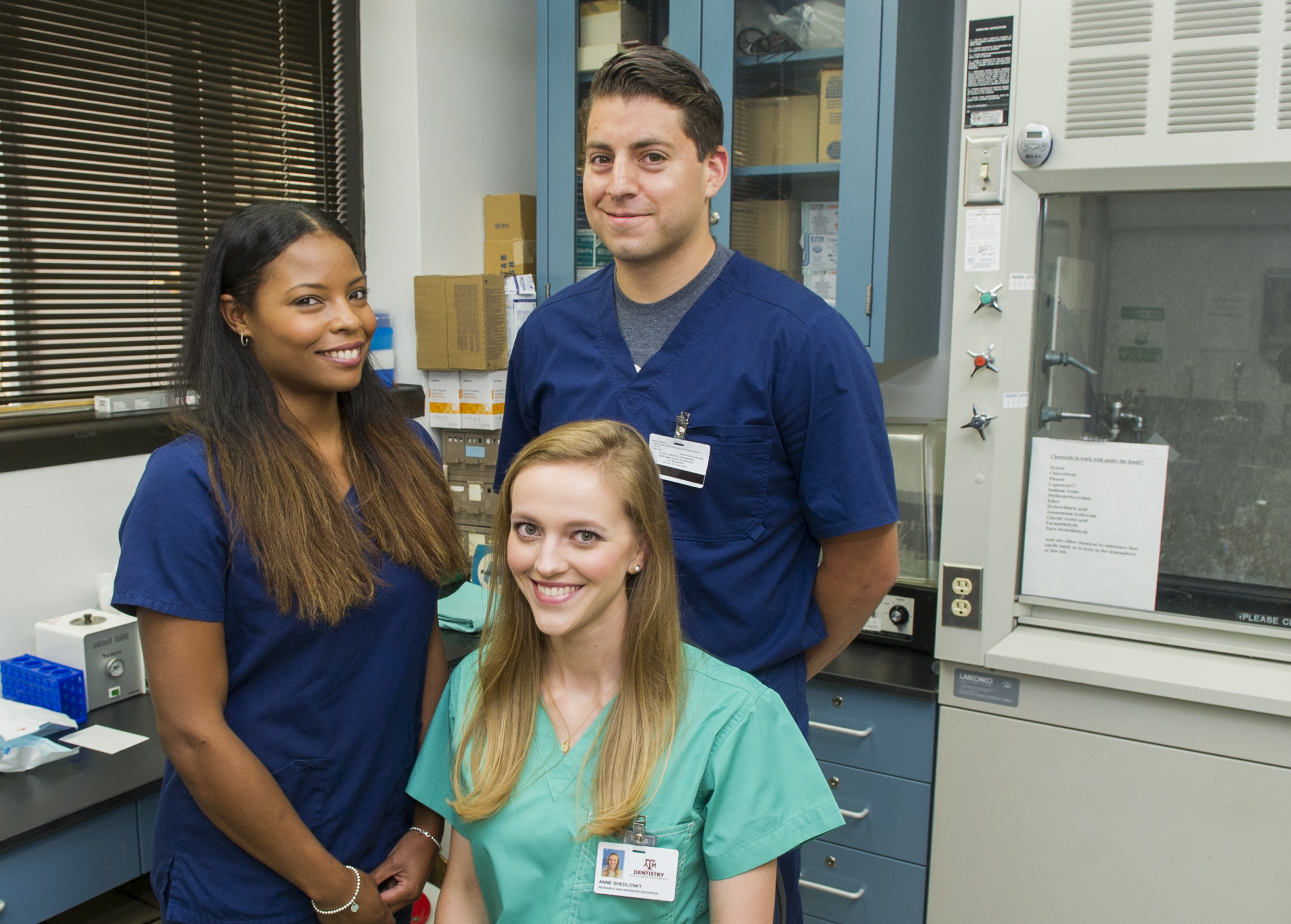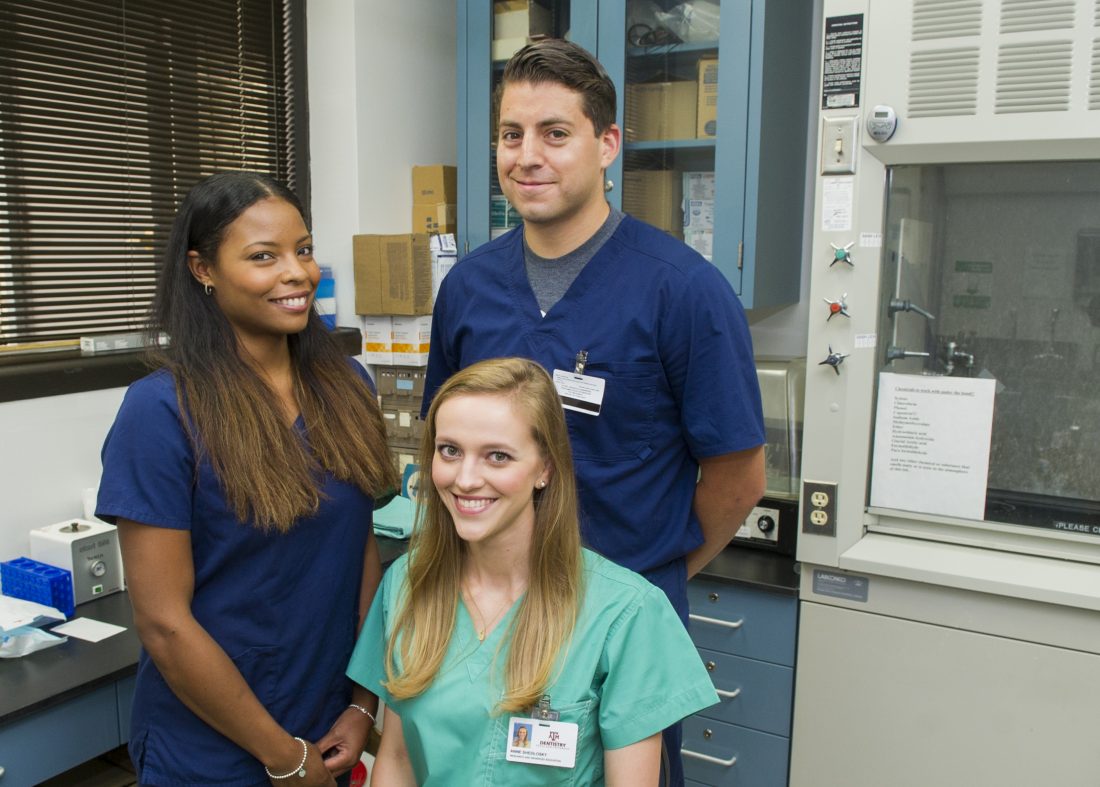A taste of research: Part 1

Research took center stage this summer for participants in the Predoctoral Student Research Program at Texas A&M College of Dentistry, who spent eight weeks working in labs around campus. For a behind-the-scenes glimpse, we asked three groups of student researchers to give us their take on their experiences. Enjoy Part 1 of this three-part series.

Daniel Maldonado, Lianna Pulliam and Anne Shedlosky
Faculty mentors: Dr. Phillip Kramer, professor in biomedical sciences; and Dr. Crystal Stinson, assistant professor in biomedical sciences
These student researchers have spent the summer in Dr. Phillip Kramer’s lab looking for more clues on how estrogen impacts orofacial pain.
“Normal hormonal levels of estrogen are known to attenuate pain, while low levels can exacerbate pain,” explains Daniel Maldonado. By modulating the levels of estrogen in a rat model and looking specifically at gene expression and estrogen receptors in the thalamus, Maldonado and his cohorts are hoping to gain more insight into the mechanics of estrogen’s influence on orofacial post-herpetic neuralgia, or PHN. PHN is a painful, chronic condition that can occur following shingles, a viral infection that can cause an intensely painful rash.
“The research project is going well, and we are hoping to get results that back the hypothesis,” says Maldonado, who conducted research while pursuing his master’s degree at the University of Texas at San Antonio and hopes to continue research at the dental school. “Since Dr. Stinson recently completed her Ph.D., I have questions for her every day. And I am learning a lot about physiology and mechanisms that will be applicable to a clinical setting.”
Maldonado’s background in research has allowed him to complete his own full-scale summer project, which he will present at the American Association for Dental Research conference next March.
In tandem with Maldonado, Anne Shedlosky is studying the thalamus – the brain’s center for pain perception – by investigating changes in the neuronal activity of the thalamus in response to PHN.
“Through immunostaining thalamus tissue samples, I can check for increased activation of cells in the thalamus and determine if the increased neuronal activity in some animals coincides with an increase in the behavioral pain response,” she says.
Shedlosky, a graduate of the University of Texas at Austin with a bachelor’s degree in finance – and a research novice – did some on-the-job training this summer, including learning how to use a cryostat, a cooling chamber commonly used in biomedical research to thinly slice isolated tissues for microscopy and immunostaining.
“As I have not previously participated in research, I am grateful for the opportunity to have worked closely with both Dr. Kramer and Dr. Stinson,” says Shedlosky. “Their knowledge and experience have given me a wealth of insight into the process of understanding biological mechanisms.
“Throughout the summer, I have learned that research involves meticulous attention to detail, and the process requires time and patience.”
Lianna Pulliam’s research experience is providing “a better understanding of the most relevant nerve in dentistry, its associated pain pathways and how pain and infection can alter the structure and function of orofacial tissues,” she says.
Pulliam’s project has entailed preparing control and Varicella – chicken pox – virus-infected animal model trigeminal ganglion for immunostaining. In the human Varicella disease process the infection is acquired at the skin and able to travel to the nearest nerve ganglion where it remains dormant unless it reactivates and causes shingles in adulthood, explains Pulliam, who majored in biology at the University of Houston and attended Rutgers University prior to the College of Dentistry.
“We do not know if an increased amount of Varicella-infected cells in the ganglion presents with increased observed pain, so counting the intensity of the infection using the stained tissues would help determine if that pattern exists,” she says.
All three student researchers agreed that their summer experience has been a positive one, especially with the opportunity to work with two “accomplished and knowledgeable” faculty mentors who bring different perspectives and levels of experience.
Editor’s note: Coordinated by Dr. Bruno Ruest, program director and associate professor of biomedical sciences, the longstanding summer research program provided opportunities for nine incoming dental students and 15 second-year students to participate this year. Baylor Oral Health Foundation contributed the majority of the funding, with additional support from the U.S. Department of Health and Human Services’ Centers of Excellence grant and the college’s Office of the Associate Dean for Research and Graduate Studies.